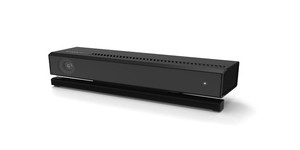
Microsoft has formally launched the latest Software Development Kit (SDK) for its Kinect for Windows depth-sensing camera platform, bringing official 3D scanning capabilities to the device for the first time.
Originally devised as a controller-free interaction platform for its Xbox 360 games console, the launch of Kinect for Windows - which came quite some time after enterprising hackers had figured out how to get the USB-connected hardware working on PCs - promised to bring new human interface capabilities to the humble desktop. Microsoft appeared to be lagging behind the hacker community when it came to finding uses for the platform, however: while the official Kinect for Windows SDK came with a few code examples, the hacker community had long since provided software for turning the device into a fully-functional 3D scanner and enabling other, more esoteric uses.
Now, Microsoft has formally launched the Kinect for Windows SDK 1.7, which adds Kinect Fusion support - bringing its official software more in-line with what the community has been achieving. Kinect Fusion allows the device, which combines a colour webcam with two depth-sensing cameras to provide the connected computer with a stream of live three-dimensional data points, to create accurate 3D models of almost any object.
Moving the Kinect sensor around the object to be scanned, the system takes multiple snapshots and combines them into a single 3D object which can be imported into almost any 3D modelling application around. This object can then be manipulated in a variety of ways, before being used - Microsoft envisions - to create a real-world object through computer aided manufacturing (CAM.) For those who don't have access to such capabilities, Microsoft is still pushing the technology: a 3D scan of a person's body, the company promises, would make it easy for a shop to demonstrate different clothing choices without having to physically try the items on; a 3D scan of a head, meanwhile, could be modified to model different glasses, earrings or hairstyles.
The update also brings Kinect Interactions, a means of pushing Kinect as the ultimate in-store advertising system. Using Kinect Interactions, developers can build new user interfaces with push-to-press buttons, grip-to-pan capabilities, and other gesture-centric methods of operation. The SDK also provides usage examples in OpenCV and MATLAB, two of the most popular computer vision and visualisation languages, along with the previously-announced move of making some code examples available under an open-source licence via CodePlex.
From the features found in the update, it's clear Microsoft is hoping to push Kinect out of the home and into industry: its support for OpenCV and MATLAB show an increasing desire to get developers outside the gaming industry supporting the device, while many of the companies demonstrations revolve around how Kinect can be used in a shopping environment to help drive sales.
Whether the company will be successful in this regard, however, remains to be seen.
Originally devised as a controller-free interaction platform for its Xbox 360 games console, the launch of Kinect for Windows - which came quite some time after enterprising hackers had figured out how to get the USB-connected hardware working on PCs - promised to bring new human interface capabilities to the humble desktop. Microsoft appeared to be lagging behind the hacker community when it came to finding uses for the platform, however: while the official Kinect for Windows SDK came with a few code examples, the hacker community had long since provided software for turning the device into a fully-functional 3D scanner and enabling other, more esoteric uses.
Now, Microsoft has formally launched the Kinect for Windows SDK 1.7, which adds Kinect Fusion support - bringing its official software more in-line with what the community has been achieving. Kinect Fusion allows the device, which combines a colour webcam with two depth-sensing cameras to provide the connected computer with a stream of live three-dimensional data points, to create accurate 3D models of almost any object.
Moving the Kinect sensor around the object to be scanned, the system takes multiple snapshots and combines them into a single 3D object which can be imported into almost any 3D modelling application around. This object can then be manipulated in a variety of ways, before being used - Microsoft envisions - to create a real-world object through computer aided manufacturing (CAM.) For those who don't have access to such capabilities, Microsoft is still pushing the technology: a 3D scan of a person's body, the company promises, would make it easy for a shop to demonstrate different clothing choices without having to physically try the items on; a 3D scan of a head, meanwhile, could be modified to model different glasses, earrings or hairstyles.
The update also brings Kinect Interactions, a means of pushing Kinect as the ultimate in-store advertising system. Using Kinect Interactions, developers can build new user interfaces with push-to-press buttons, grip-to-pan capabilities, and other gesture-centric methods of operation. The SDK also provides usage examples in OpenCV and MATLAB, two of the most popular computer vision and visualisation languages, along with the previously-announced move of making some code examples available under an open-source licence via CodePlex.
From the features found in the update, it's clear Microsoft is hoping to push Kinect out of the home and into industry: its support for OpenCV and MATLAB show an increasing desire to get developers outside the gaming industry supporting the device, while many of the companies demonstrations revolve around how Kinect can be used in a shopping environment to help drive sales.
Whether the company will be successful in this regard, however, remains to be seen.

MSI MPG Velox 100R Chassis Review
October 14 2021 | 15:04








Want to comment? Please log in.